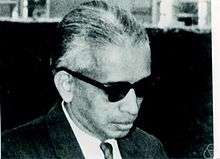K. G. Ramanathan
| K. G. Ramanathan | |
|---|---|
 | |
| Born |
November 13, 1920 Hyderabad, British India |
| Died |
May 10, 1992 (aged 71) Bombay, India |
| Citizenship | Indian |
| Fields | Number theory |
| Institutions | TIFR |
| Alma mater | Princeton University |
| Doctoral advisor | Emil Artin |
| Doctoral students |
C. P. Ramanujam Kanakanahalli Ramachandra |
| Notable awards | Padma Bhushan |
| Spouse | Jayalakshmi Ramanathan |
Kollagunta Gopalaiyer Ramanathan (November 13, 1920 – May 10, 1992) was an Indian mathematician known for his work in number theory. His contributions are also to the general development of mathematical research and teaching in India.
K. G. Ramanathan's early life and his family
K. G. Ramanathan was born in Hyderabad in South India. He completed his B.A. and M.A. in mathematics at Osmania University and the University of Madras respectively before going to Princeton to earn his Ph.D; his advisor was Emil Artin. At Princeton, Ramanathan also worked with Hermann Weyl and Carl Siegel. Thereafter he returned to India to team up with K. Chandrasekharan at the Tata Institute of Fundamental Research (TIFR) at Colaba in 1951. At Princeton, for about two years, Ramanathan's neighbour was Albert Einstein, legendary physicist. He used to sing Carnatic songs of Thyagaraja to Einstein for entertainment.
Ramanathan was married to Jayalakshmi Ramanathan. He is survived by two sons. His father's name was Kollagunta Gopal Iyer, and his mother's name was Ananthalaxmi. His mother died at an early age. He had two sisters and one brother.
Career
At TIFR, he built up the number theory group of young mathematicians from India. For several years, he took interest to study Ramanujan's unpublished and published work. He was an Editorial board member of Acta Arithmetica for over 30 years. He retired from TIFR in 1985.
Awards
Ramanathan was given numerous achievements during his more than 30 years service at TIFR.
- Padma Bhushan, 1983[1]
- Shanti Swarup Bhatnagar Award, 1965
- Fellow of Indian Academy of Sciences
- Fellow of Indian National Science Academy
- Honorary fellow of TIFR.
Selected publications
- On Ramanujan’s continued fraction, KG Ramanathan - Acta Arith, 1984
- Some applications of Kronecker’s limit formula, KG Ramanathan - J. Indian Math. Soc, 1987
References
- ↑ "Padma Awards" (PDF). Ministry of Home Affairs, Government of India. 2015. Archived from the original (PDF) on November 15, 2014. Retrieved July 21, 2015.
External links
- K. G. Ramanathan at the Mathematics Genealogy Project
- Obituary, reproduced from Acta Arithmetica, Author: S. Raghavan
- K. G. R's Photo This is reproduced from Acta Arithmetica 64 (1993) 1-6
- K. G. Ramanathan's Biography